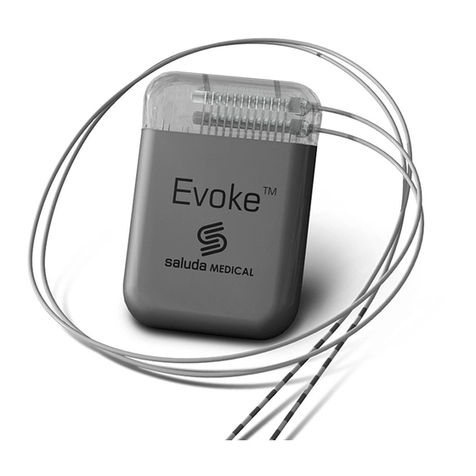
Evoke® SCS System Clinical Manual
CLIN-UMAN-005175 Revision: 9.00 Page 2 of 101
Table of Contents
1 DESCRIPTION ................................................................................................................... 5
1.1 THE CONCEPT OF ECAP-CONTROLLED CLOSED-LOOP SCS ............................................................ 5
1.2 STIMULATION FEATURES ....................................................................................................... 5
1.3 MEASUREMENT FEATURES .................................................................................................... 6
1.4 SYSTEM COMPONENTS ......................................................................................................... 8
2 INDICATION FOR USE ..................................................................................................... 10
3 CONTRAINDICATIONS .................................................................................................... 10
4 SAFETY INFORMATION ................................................................................................... 10
4.1 PRECAUTIONS ................................................................................................................... 10
5 INTRODUCTION .............................................................................................................. 12
5.1 EVOKE CLINICAL INTERFACE (CI) ........................................................................................... 12
5.2 EVOKE CLINICAL SYSTEM TRANSCEIVER (CST) ......................................................................... 12
6 CLINICAL INTERFACE – GENERAL PROGRAMMING USING THE CPA ................................. 13
6.1 CONNECTING THE CI TO THE CST AND ECLS/CLS .................................................................... 13
6.2 SET STIMULATOR TIME ........................................................................................................ 15
6.3 CHECK STIMULATOR BATTERY VOLTAGE .................................................................................. 16
6.4 RETRIEVE OR SET THE PATIENT ID AND PATIENT ZONE ............................................................... 16
6.5 MEASURE ELECTRODE IMPEDANCES ....................................................................................... 18
6.6 SET UP LEAD ORIENTATION .................................................................................................. 19
6.7 PROGRAMMING OVERVIEW ................................................................................................. 20
6.8 CHOOSE THE STIMULATION ELECTRODES AUTOMATICALLY .......................................................... 20
6.9 START AND STOP STIMULATION WITH CLOSED-LOOP DISABLED .................................................... 21
6.10 SET UP ECAP MEASUREMENT .............................................................................................. 23
6.11 SET UP CLOSED-LOOP STIMULATION ...................................................................................... 29
6.12 SET APPROPRIATE LIMITS AND INCREMENTS ............................................................................. 30
6.13 ENABLE CLOSED-LOOP STIMULATION ..................................................................................... 31
6.14 START AND STOP STIMULATION WITH CLOSED-LOOP ENABLED ..................................................... 33
6.15 SAVE A PROGRAM TO THE STIMULATOR .................................................................................. 34
6.16 CREATE A NEW PROGRAM OR USE PROGRAMMING FEATURES AND SETTINGS .................................. 36
6.17 DISCONNECT FROM THE STIMULATOR AND CLOSE THE CPA ........................................................ 36
7 CLINICAL INTERFACE – PROGRAMMING FEATURES ........................................................ 37
7.1 STIMULATION WAVEFORM .................................................................................................. 37
7.2 CLEARCAP ...................................................................................................................... 38
7.3 CURRENT STEERING ........................................................................................................... 39
7.4 MEASUREMENT ELECTRODE SCAN ......................................................................................... 40
7.5 INTERLEAVED STIMULATION ................................................................................................. 45
7.6 ACTIVATION PLOT LEVELS .................................................................................................... 49
7.7 DATA FILES ...................................................................................................................... 50
7.8 NEUROPHYSIOLOGICAL MEASUREMENTS ................................................................................ 51
7.9 ADDITIONAL IMPEDANCE MEASUREMENTS .............................................................................. 57
7.10 PATIENT SURVEY ............................................................................................................... 57
8 CLINICAL INTERFACE – SETTINGS GUIDE ......................................................................... 59
8.1 STIMULATION SETTINGS MENU ............................................................................................. 59
8.2 MEASUREMENT AND FEEDBACK SETTINGS MENU ...................................................................... 60
































